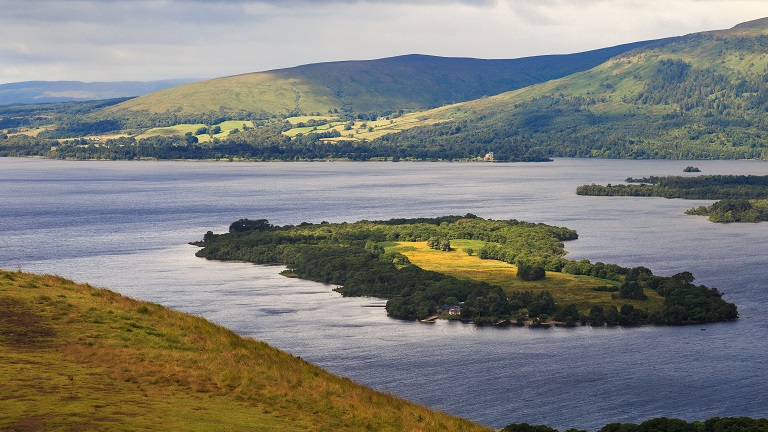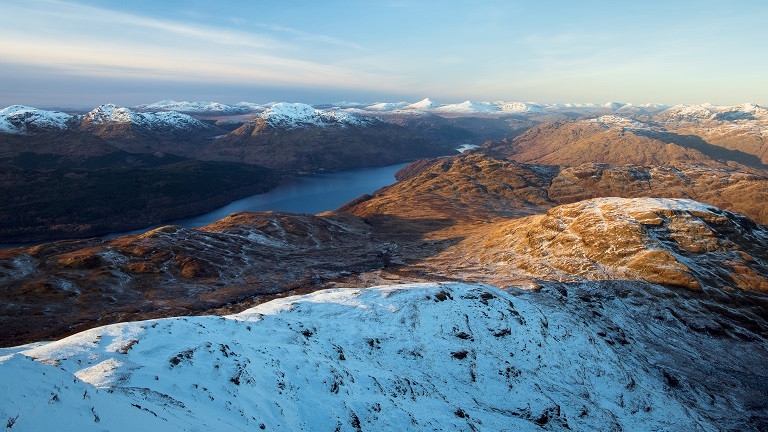If you are looking to spend time nearby, you’ll definitely want to read through our top facts about Loch Lomond – ready to set your curiosity alight and wow your loved ones with intriguing information about one of the UK’s largest lakes.
Loch Lomond is a freshwater lake nestled between the highlands and lowlands of Scotland. Part of the Loch Lomond and the Trossachs National Park, it draws visitors from far and wide looking to enjoy its wild spaces and abundant natural beauty.
Why it’s called Loch Lomond
Loch Lomond was originally called Loch Leamhain, or elm water, after the River Leven that flows from it. There are a few different versions regarding the origins of its modern name, Loch Lomond, but many believe that Lomond comes from the Scotts Gaelic word laom, or beacon, referring to nearby mountain Ben Lomond as Beacon Mountain.
Great Proportions

Loch Lomond is known as a ‘ribbon lake’ and is just shy of 23 miles long and up to 5 miles wide. At its deepest point, the loch’s underwater canyons descend to a depth of about 502ft, evoking a somewhat eerie feeling in anyone crossing its inky waters. With a surface area of 27.5 square miles, it’s actually the largest lake in Great Britain by surface area and the second largest lake in Great Britain by water volume (pipped to the post by Loch Ness).
The Monster Within
Stories of the Loch Ness Monster have travelled far and wide, but did you know that Loch Lomond is believed to have its own beastie too? Over the years, there have been several sightings of the Loch Lomond Monster, a creature resembling a plesiosaur or large crocodile, recorded. And, with the lake’s sheer size and depth, more often than not people tend to find themselves thinking maybe, just maybe…
The Highland Boundary Fault
Loch Lomond is situated on the Highland Boundary Fault, a major fault zone in the earth’s crust that runs across Scotland from Arran and Helensburgh on the west coast to Stonehaven in the east. The fault zone separates two very different types of geological terrain: the Highlands in the north and the Lowlands in the south. Naturally, it’s a site of great scientific interest and is studied by geologists all over the globe.
Intriguing Islands

Within the watery confines of Loch Lomond are 22 islands and 27 islets – many of which have inch in their name, meaning island. Some private and some open to the public, they all have unique and intriguing stories. Some of our favourites include Inchmurrin, Great Britain’s largest freshwater loch island, and Inchcailloch, which both can be explored by visitors and offer stunning views of the surrounding scenery. Inchconnachan is also a particular talking point for its resident population of wallabies. Yes, really.
High Places

Set within the Trossachs National Park, Loch Lomond is graced with some of the most jaw-dropping scenery in the UK. In fact, all around the lake are stunning mountains and Munros that appeal to everyone from photographers to hikers for their magnetic appeal. The most famous, Ben Lomond, sits on the eastern shore of Loch Lomond and is the most southerly of the Munros. Reaching a height of 3,196ft, it affords incredible views and is one of the most popular climbs in the country.
Feeling inspired? Take a look at our luxury cottages in Scotland here.